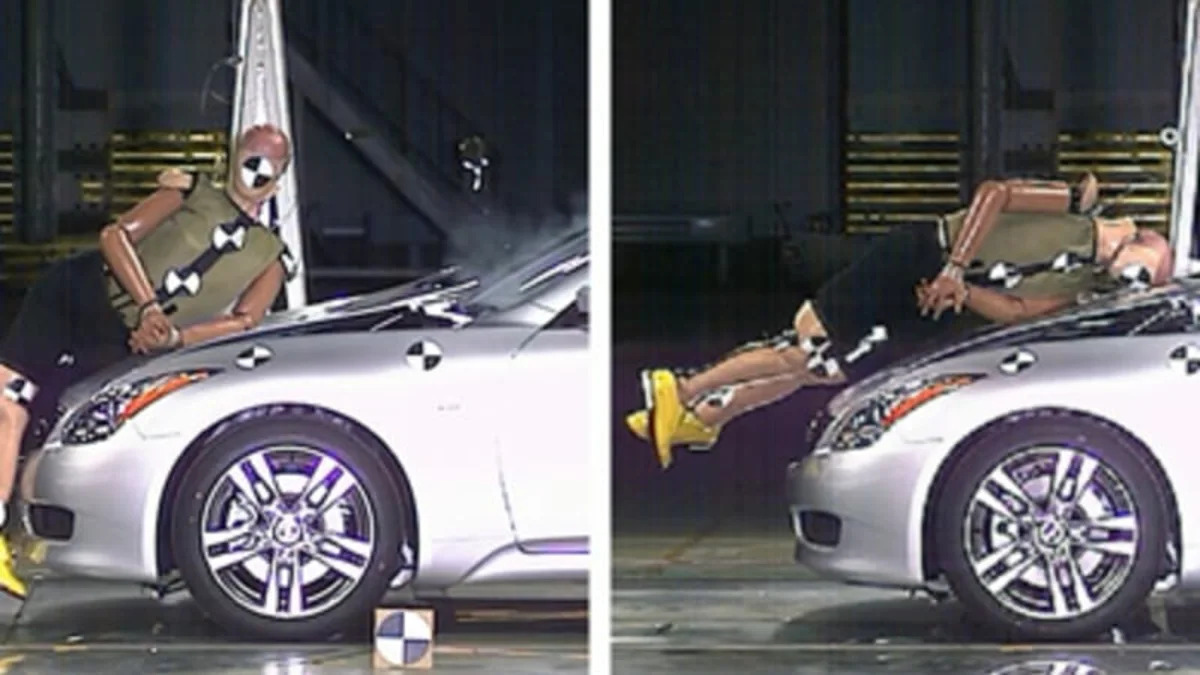Safety standards are getting tougher the world over, and in Europe newish regulations require more protection for pedestrians in a collision. In the past, designers have coped with these regs by adding more square footage to the front of a car, making the hoodline higher to put more space between a pedestrian and the engine components of a car if a collision were to occur.
Jaguar developed a new way to cope with the safety question when it debuted its Pyrotechnic Pedestrian Deployable Bonnet System on its XK line of cars in 2005. The swoop-nosed XK features small explosive charges beneath its bonnet that will blow the hood up a few inches in the event of a collision with a pedestrian.
Nissan has announced that it will include similar technology on its new Skyline, although they're going with the less sensational name "pop-up engine hood". Like with the XK, the pop-up engine hood on the Skyline will allow Nissan designers more freedom in sculpting the car's nose while still meeting various safety standards in different world markets.
[Source: Nissan]
PRESS RELEASE:
NISSAN REVEALS NEW "POP-UP ENGINE HOOD" SAFETY TECHNOLOGY
TOKYO (August 2, 2007)--Nissan Motor Co., Ltd. has developed an innovative "pop-up engine hood" to help reduce head impact injuries in the event of a pedestrian collision. The new safety feature will debut on the new Skyline coupe, set for release this fall in Japan.
The concept of the pop-up hood is based on a very simple principle: to help minimize serious head injury by creating more space to avoid collision with hard objects. In the case of a car-pedestrian collision, the engine hood is designed to pop-up instantly to help create a protective buffer space between the hood and the engine components underneath.
Upon impact with a pedestrian and based on the severity of that impact, a sensor incorporated in the bumper activates the pop-up control-unit which in turn will trigger an explosive actuator that raises the hood.
The pop-up hood also allows car designers greater freedom in having to balance the aesthetic of a streamlined hood design with the safety benefits of adding more protective space over the engine components.
On a global level, Nissan is committed to build safer vehicles equipped with advanced safety technologies. In Japan, the company's safety vision is to halve the number of traffic fatalities or serious injuries involving Nissan vehicles by 2015 compared with the level in 1995.
Jaguar developed a new way to cope with the safety question when it debuted its Pyrotechnic Pedestrian Deployable Bonnet System on its XK line of cars in 2005. The swoop-nosed XK features small explosive charges beneath its bonnet that will blow the hood up a few inches in the event of a collision with a pedestrian.
Nissan has announced that it will include similar technology on its new Skyline, although they're going with the less sensational name "pop-up engine hood". Like with the XK, the pop-up engine hood on the Skyline will allow Nissan designers more freedom in sculpting the car's nose while still meeting various safety standards in different world markets.
[Source: Nissan]
PRESS RELEASE:
NISSAN REVEALS NEW "POP-UP ENGINE HOOD" SAFETY TECHNOLOGY
TOKYO (August 2, 2007)--Nissan Motor Co., Ltd. has developed an innovative "pop-up engine hood" to help reduce head impact injuries in the event of a pedestrian collision. The new safety feature will debut on the new Skyline coupe, set for release this fall in Japan.
The concept of the pop-up hood is based on a very simple principle: to help minimize serious head injury by creating more space to avoid collision with hard objects. In the case of a car-pedestrian collision, the engine hood is designed to pop-up instantly to help create a protective buffer space between the hood and the engine components underneath.
Upon impact with a pedestrian and based on the severity of that impact, a sensor incorporated in the bumper activates the pop-up control-unit which in turn will trigger an explosive actuator that raises the hood.
The pop-up hood also allows car designers greater freedom in having to balance the aesthetic of a streamlined hood design with the safety benefits of adding more protective space over the engine components.
On a global level, Nissan is committed to build safer vehicles equipped with advanced safety technologies. In Japan, the company's safety vision is to halve the number of traffic fatalities or serious injuries involving Nissan vehicles by 2015 compared with the level in 1995.


Sign in to post
Please sign in to leave a comment.
Continue